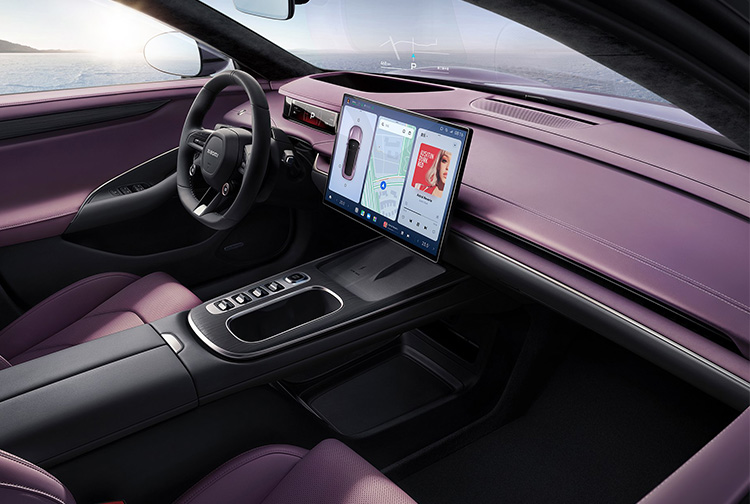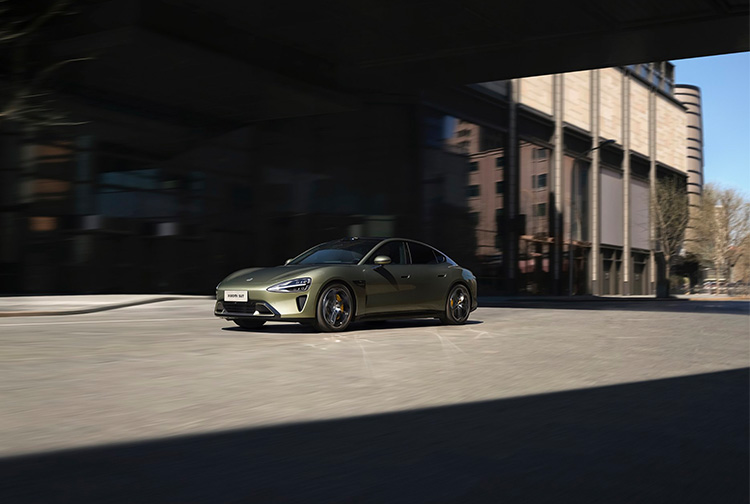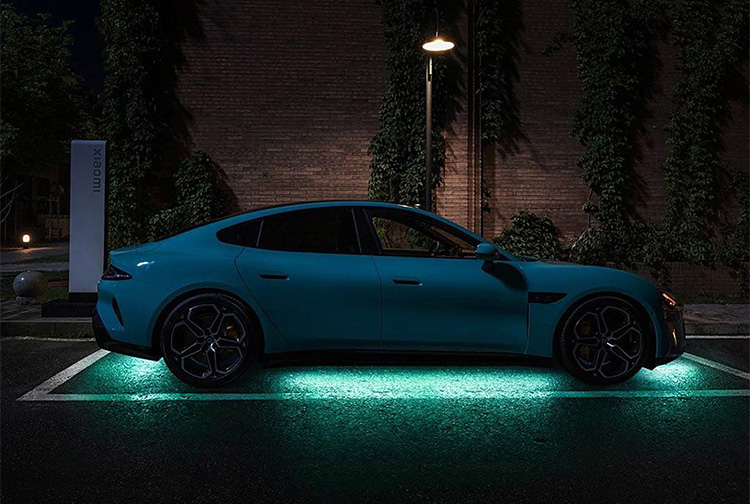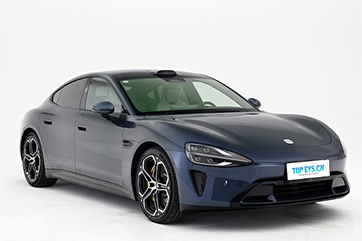The
Xiaomi SU7 might be the most talked-about model of 2024. There are plenty of videos discussing this car, but few manage to clearly explain the differences between the entry-level, mid-tier PRO, and top-tier MAX versions in one comprehensive review. How much range difference is there between the base model and the mid-tier PRO? What are the charging speed differences between the 800V and 400V platforms under various power outputs? Does the presence or absence of LiDAR make a significant difference in the driving assistance system? And in real danger, where are the boundaries of their AEB capabilities? To answer these questions, the only way is to test all three models side by side, which is what we did in this comprehensive review of the
Xiaomi SU7 range.
The differences in appearance between the base, PRO, and MAX models are minimal. All three cars, in sync, chose the 19-inch energy-saving wheel and tire package beneficial for range. Fortunately, they chose different colors: Olive Green for the standard version, Bay Blue for the PRO, and Yahui for the MAX. Regular buyers of the Xiaomi SU7 will find this familiar, as these are the three free colors offered by Xiaomi, emphasizing cost savings. The top-spec MAX version comes with a standard electric rear wing, which is optional for the PRO at a cost of 6,000 yuan. Additionally, the MAX, being the performance version, has an exclusive red badge, while the other two models only have a plain badge.
Let's start with the performance testing. Compared to acceleration, I believe everyone is more concerned about the braking performance of the Xiaomi SU7, and so am I. After all, I wouldn't want to wreck three cars in one afternoon. We're skipping the track as 99% of Xiaomi users probably won't take their cars there, but we will subject all three models to a rigorous test of 0-100 km/h acceleration followed by hard braking, 15 times in a row. After 45 runs, we obtained the performance data for all three cars.
Regarding acceleration, the official figures for the three models are 2.78 seconds, 5.7 seconds, and 5.28 seconds respectively. Our best real-world results were 3.17 seconds, 5.57 seconds, and 5.38 seconds. It's normal for the MAX version to be slightly slower than the official figure because Xiaomi's 2.78 seconds was achieved using a one-foot rollout mode, whereas most domestic manufacturers and media include the launch time in their standard mode tests. The PRO and standard versions performed well, even slightly faster than the official figures. In the repeated tests, the performance remained impressive, with the times for the 15th run being 3.2, 5.68, and 5.45 seconds, respectively. The continuous output capability of the power systems across all models is commendable.
In terms of braking, we focused on the last five tests. The MAX version consistently performed between 38 and 39 meters, with the last run at 38.74 meters, showing no significant increase compared to the first ten runs. The limitation in its braking system comes from the 245/45R19 Michelin e.Primacy tires. If you opt for the 20- or 21-inch sport wheels and tires, our previous tests showed braking distances could be reduced to around 36 meters. Hence, it’s advisable to choose the sport wheel and tire package for the MAX version. The PRO version showed some heat fade, with distances ranging from 39 to 42 meters after the first 38-meter stop. The standard version also showed some heat fade, with the last few tests reaching around 41 meters, but it remained within an acceptable range.

After discussing braking, let's talk about range, which is a major concern for many. All three test cars were equipped with 19-inch energy-saving wheels, which represent the upper limit of each model's range. The PRO version has the largest battery at 94.3 kWh but is single-motor, achieving a CLTC range of 830 km. The MAX version, despite having a 101 kWh battery, achieves only 810 km due to its high performance and dual motors. The standard version, with a 73.6 kWh battery and single motor, has a CLTC range of 700 km. We conducted our range tests primarily on highways and urban loops with speed limits between 80 and 120 km/h. Starting from a fully charged state at a highway service area, each car was driven in comfort mode with air conditioning set to 23°C, until the range indicator hit zero.
For the standard version, the actual range was 562 km, with a range achievement rate of 80.3%. The PRO version achieved 682 km, with an achievement rate of 82.2%. The MAX version, thanks to its energy-saving wheels and tires, managed 668 km, just 14 km less than the PRO version, with an achievement rate of 82.5%. Overall, the real-world range and achievement rates for all three models are impressive, with the standard version exceeding 500 km, which should suffice for most users, typically lasting a week on a single charge.
When the Xiaomi SU7 was launched, one significant controversy was that only the top-spec version had an 800V platform, while the mid and lower-spec models used a 400V platform. Today, we tested the charging speeds of the 400V PRO and standard versions and the 800V MAX version. We conducted two tests: one using a common 120 kW national grid charger and another using a 400 kW ultra-fast charger. The 120 kW test is more representative of current charging speeds, while the 400 kW test reflects potential future speeds when ultra-fast chargers become more widespread.
In the 120 kW charging test, the two 400V models showed similar performance. From 0-65%, they charged at around 110 kW but began to slow down as they approached 70%, dropping to around 70 kW at 80% charge. The standard version, with a slightly higher charging power and smaller battery, took less time to charge than the PRO. The MAX version, on the other hand, performed exceptionally, reaching a peak of 200 kW by utilizing the power from the unused second gun of the dual-gun charger, reducing the time to charge from 10% to 80% to just 24 minutes, 16 minutes faster than the PRO.

In the 400 kW test, the results were similar but overall faster. The 400V models were again close in performance, with the standard version slightly faster. The 800V MAX version dominated, reaching over 300 kW and charging from 10% to 80% in just 20 minutes, still 16 minutes faster than the PRO. Both tests show the MAX’s impressive charging capabilities, while the 400V models perform well within their potential and show good adaptability to different charger brands and power levels.
LiDAR has been a hot topic, often highlighted in manufacturer presentations and media reviews, but these are usually based on the top-spec models. The mid and low-spec models’ capabilities remain less known, which is why we tested them. The
Xiaomi SU7’s driving assistance systems differ between the high-end (MAX and PRO) and low-end (standard) versions, primarily in the presence of LiDAR and additional rear millimeter-wave radars in the high-end versions. The computing power of the high-end system is also significantly higher.
In our testing at the end of May, city navigation was not yet available, so we focused on highway navigation and active safety. In highway navigation, there was no significant difference between the high-end and low-end systems. In 95% of cases, the systems performed well, maintaining lane centering, managing following distance, overtaking slower vehicles, and handling large-radius bends smoothly. They also responded calmly to fast cars merging ahead, slowing down slightly without overreacting. Both systems managed to merge onto and off the highway without issues when traffic was moderate.
However, there are situations where users need to stay alert. For example, when encountering roadwork without proper signage, the SU7 might choose to stop rather than change lanes. Additionally, if there are vehicles stopped on the inner lane, the SU7 might also come to a halt, requiring driver intervention. These instances highlight the system’s limitations and the need for driver vigilance, even though the system performs well most of the time.
We also tested the systems’ active safety capabilities with four scenarios: AEB rear-end collision prevention, AEB pedestrian detection, LC rear-end collision prevention, and LC fixed object detection. The differences between AEB and LC lie in how they simulate the vehicle’s response, either with or without driver assistance activated.
In the AEB rear-end collision prevention test at 80 and 120 km/h, all three models recognized the dummy car and stopped in time, avoiding collisions. Even at 130 km/h, they performed well. At 140 km/h, they could detect and react but ultimately required driver intervention to stop.
The AEB pedestrian detection test simulated a child suddenly crossing the road at 30 and 70 km/h. All three models successfully recognized, alerted, and decelerated to avoid collisions.
In the LC rear-end collision prevention test, with LC activated at 120 and 130 km/h, all three models detected the dummy car early, provided alerts, and braked linearly, avoiding collisions.
Lastly, the LC fixed object detection test involved a 50x40x40 cm cardboard box, representing a non-standard object. The MAX and PRO models, equipped with higher-end systems, successfully recognized and stopped for the box, while the standard model did not detect it, requiring driver intervention.
In summary, let’s review from the base to the top model. For the
entry-level version at
RMB 215,900, concerns might include the smaller battery and lower-end
driving assistance. However, it still offers a 0-100 km/h time of around 5.5 seconds, a real-world range exceeding 500 km, and consistent braking performance. While it lacks LiDAR and has a slower 400V charging platform, its active safety is adequate, though not as advanced as the higher-end versions. Considering its price, it remains a cost-effective choice.
For the
PRO version at
RMB 289,900, it offers an impressive 830 km range, slightly enhanced performance, and additional features like the availability of the 800V charging platform. However, the true value comes from its balance between range, performance, and technology, making it suitable for those seeking more without reaching for the top-tier model.
The
top-spec MAX version, starting at
RMB 329,900, brings significant upgrades, including faster acceleration, the 800V charging platform, enhanced braking with optional sport tires, and superior driving assistance with LiDAR. While its range is slightly less than
the PRO due to dual motors, its performance and technological advantages justify the higher price.
In conclusion, all three models of the Xiaomi SU7 offer unique strengths catering to different needs. Whether you prioritize range, performance, or advanced technology, there’s an option to suit your requirements, making the Xiaomi SU7 a competitive choice in the electric vehicle market.
Contact us to get the configuration-based quotes for the Xiaomi SU7. In addition, the Xiaomi SU7 Ultra and Xiaomi YU7 are available for sale—feel free to reach out for more details. 






.jpg)
.jpg)
.jpg)
.jpg)

.jpg)




